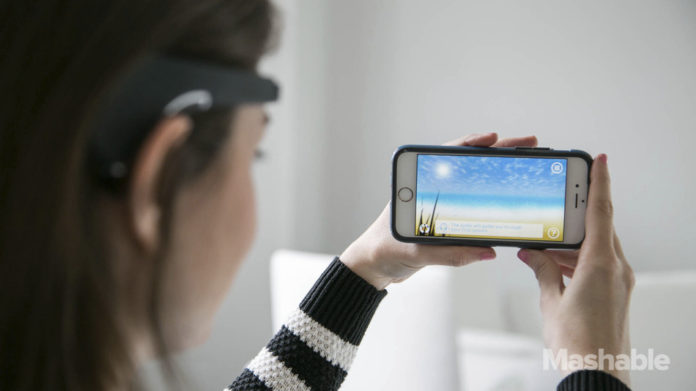Brain-Sensor Wearable Headbands De-Stress You in Minutes

I’m staring at a beach and listening for seagulls in the distance. When a voice asks me to concentrate on my breathing, requesting I count in sequences of ten, I follow the command and my body starts to loosen.
But then I get distracted by the sounds of ocean waves nearby. I accidentally skip a number and I’m fixated on the mistake. In response to my elevated fluster, the wind starts to pick up, and I’m told only my brain waves can bring the cadence of the environment to normalcy again. Eventually, the wind resumes to a calm blow as I get back in control.
Despite my idyllic surroundings, I’m sitting at my desk in the middle of a busy newsroom, wearing what looks a little like Google Glass for the forehead and a pair of headphones. The device is called the Muse. It’s a $300 brain-sensing headband born out of a popular Indiegogo campaign. (We took our first look at the Muse last month.) I’ve been participating in a series of calming exercises that are supposed to chill you out in a few minutes yet give you the effects of a nearly 30-minute yoga session.

Image: Christina Ascani/Mashable
I haven’t reached the point of zen, but I’m noticeably more relaxed than I was just three minutes ago. I hold my iOS device in my hand and check out my results via the corresponding Muse app.
I’ve improved my calmness the past few times I’ve tried the exercises (which vary in time, from three minutes to 20, based on your preference), but I still can’t hear as many birds as I’m supposed to throughout the activity. The app reveals that my brain has picked up on only some of their chirps, meaning I’ve been able to control my breathing and thoughts while dismissing background noise like the waves, but I’m missing tiny details like the sounds of the birds in the scene. I’m getting there.
The Muse headband is a part of a new group of devices that merge relaxation with wearable technology to make you more aware of your overall being. There’s no shortage of technology that helps you improve yourself, from the tennis racquet that improves your swing to the toothbrush that makes sure you don’t miss a spot. Fitness and health-related tracker devices dominate the wearable space, too — there are wristband trackers that help you run marathons and a high-tech yoga mat that helps you work on poses.
While the earlier part of the trend has to do with physical productivity, there’s now a greater focus on the mental side, impacting the way you think, slowing you down and alleviating the stresses and anxiety of everyday life.
Portability is key — in the case of the Muse device, all you need is the product, a mobile phone or tablet and a little bit of time. Actually, you don’t even need the product (you can use the app as a standalone) and even better, it’s something you can do on the couch, on an airplane or at the office. Muse turns the relaxation process into a game, so if your mind easily wanders, this method helps you focus in other ways.

Image: Mashable, Niki Walker
Of course, the experience is heightened if you buy the headband, which measures the electrical signals from your brain with the help of seven sensors — three in the center that establish a basis of brain activity, two behind the ears and two others off to the sides — all of which collect and translate data into feedback you can understand.
Getting the sensors to evenly line up to certain parts of your head is perhaps the only stressful part of the experience. You’ll need to make sure each sensor is positioned on your head properly — it took me a good five minutes (and at other times, even longer) to master the alignment. But after everything was in place, I started my mental workout. Or rather, the quest to de-stress.

Image: Mashable, Niki Walker
Another unwinding-with-your-mind device that’s been much discussed in the Silicon Valley scene lately is the Thync, which (similar to the Muse) uses senses to detect your brain’s activity and helps users become more energized, focused or calm. It’s like getting a boost of caffeine or supplements without the need to do so, the company says. Thync, which recently received $13 million in funding from Khosla Ventures, plans to put out its first product in 2015.
Although details about the product are slim, Thync says it has combined neuroscience with consumer wearables and algorithms that will help people transition from a busy day to a relaxing evening. And if the funding win is any indication, the industry is banking on this as part of the future of wearable tech.
Muse and Thync aren’t alone in this field — there are other brain-sensor headpieces like Emotiv and Brainbot that read feedback from your mind, too. But as the wearable category becomes inundated with productivity-driven machines, like smartwatches that track movements, send you emails and let you take calls, there’s also a movement within the space to declutter your mind.
And it comes at just the right time: we’ll likely need more of these calming tools as technology like the Apple Watch will capture more of our mental focus in the months ahead.
Have something to add to this story? Share it in the comments.
